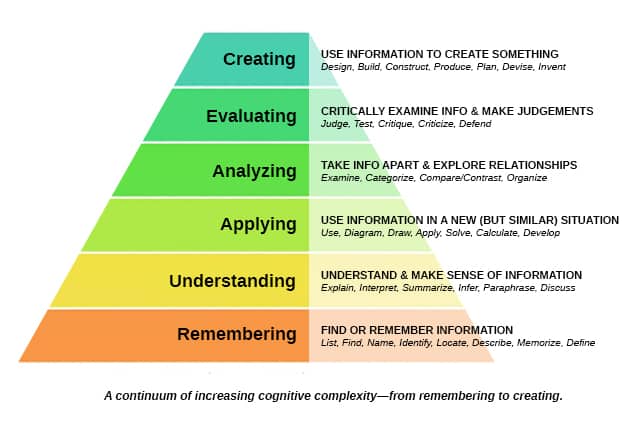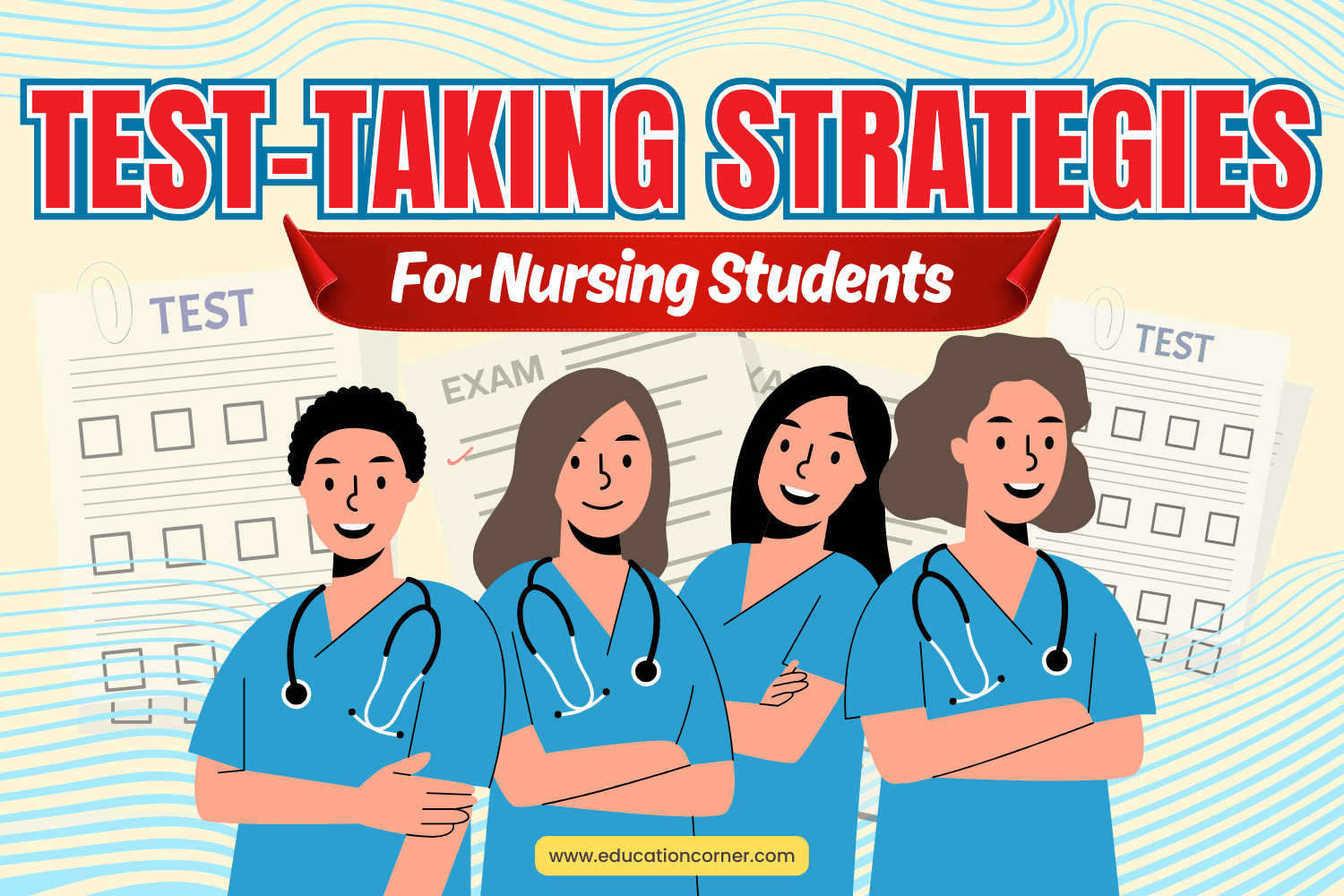Want to start acing your nursing exams? It really is possible. It just takes dedication, work and studying smarter. If you’ll take the time to review the strategies and recommendations below, take them to heart, and apply them in your studies, we guarantee you’ll see a marked improvement in your test taking ability and exam scores.
The Anatomy of a Multiple Choice Question
Whether it’s an end of semester final, the NLE or the NCLEX, multiple-choice questions are the standard question format on nursing tests and exams. Understanding the various parts of a multiple choice question, as presented on nursing exams, is essential for improving your test-taking ability.
The following are four basic parts of the multiple choice question.
- Case – Description of the patient situation. Presents the scenario of what is happening.
- Stem – The part of the question that presents the specific question being asked.
- Distractors – Answer choices at are feasible but ultimately incorrect. They do not provide the best answer.
- Correct Response – The response that best answers the question.
Consider the following sample multiple-choice question:
| Case Scenario | A young man is admitted to the emergency room with pain in his right lower quadrant. Acute appendicitis is suspected. Which healthcare provider prescription should the nurse implement first? |
| Stem | Which health care provider prescription should the nurse implement first? |
| Distractors (Incorrect Answers) | 1. Administer 5-325 mg hydrocodone/acetaminophen PO for pain 2. Draw blood for complete blood count and electrolyte levels 3. Obtain urine specimen for urinalysis |
| Correct Answer | 4. Start intravenous (IV) line with normal saline 100 mL/hr |
Rationale:
This above question tests a student’s knowledge and understanding of prioritization of care. While answer choices 1, 2 and 3 are feasible options, there is only best option for the question being asked in the stem based on prioritization of care.
When prioritizing multiple prescriptions, the nurse should first address issues of airway, breathing, circulation, and then vitals. For acute appendicitis, initial interventions would include the following:
- First, ensure patent airway and administer oxygen if hypoxic
- Second, obtain IV access and administer prescribed fluids (Option 4)
- Third, draw blood samples for complete blood count (CBC), electrolyte levels, clotting studies, and type and cross as prescribed (Option 2)
- Fourth, insert indwelling urinary catheter and obtain urine sample for urinalysis, if prescribed (Option 3)
- Finally, insert a nasogastric (NG) tube if necessary
(Option 1) Clients who are experiencing acute appendicitis are at risk for rupture of the appendix and often require emergency surgery. In such cases, the nurse must maintain NPO status. Pain medications are to be administered intravenously.
Based on prioritization of care protocols, and the answer choices presented, option 4 is the best, and ultimately correct, answer to the question.
Basic Rules of Test-taking
1. Read all instructions provided thoroughly and carefully.
2. Read each test question (stem) carefully and identify what the question is seeking.
3. Do not read into a question anything beyond what is stated. Only answer what is being asked.
4. Pace yourself. Don’t take too long on any one question, but give yourself time.
5. Answer all questions on the exam, even it requires educated guessing.
Reading the Question
- Read the entire question
- Restate the question in your own words. What is the question (stem) asking for?
- What are the keywords in the question?
- What are the answer options?
Note: Keywords are any words that identify or describe the client, problem or details of the problem. Keywords may identify factors such as age, sex, marital status, disease/condition, symtoms, or duration of any of the aforementioned.
Identify the Time Frame
Time is relevant to answering many nursing test questions. If time is mentioned in the case scenario or stem, it’s important, so pay attention. Examples, of time in test questions include:
- Early vs. Late
- Pre Operative vs. Post Operative
- Surgical Day
Identifying the Correct Answer
There are several steps, exercises and strategies to identifying correct answers on nursing tests. These include:
- Answer the question in your head before looking at the answer options.
- Read all the answer choices before selecting an answer.
- While several answer options may be feasible, there is only one best answer. The best answer is the correct answer.
- Identify the central person in the question. The correct answer will always focus on the central person.
- Sometimes the same words will appear in both the question and the correct answer.
- When two answer choices are the opposite of one another, one is usually the correct answer.
- When multiple answer choices are substantially similar they’re usually incorrect.
- Answers with false words (ie. except, least likely, never, not, etc.) indicate a wrong nursing action is the correct choice.
- Answer choices that include absolutes, such as always, every, must, never, none, etc., are usually incorrect.
- Answer choices with inappropriately client focused care (not focused on physical and emotional needs of the client) are usually incorrect.
- When a stem includes initial, first, or best as part of the question, there will likely be several feasible answer options, but only one answer that is best. To find the best answer option, you’ll need to use nursing prioritization techniques.
Strategies for Making Educated Guesses
When you’re uncertain which is the correct, or “best”, answer option, make an educated guess. The following are strategies for improving your chance of selecting the correct answer when making an educated guess.
- Use the process of elimination.
- Eliminate any answer choice that does not respond to the question being asked in the stem, even if it provides a correct answer.
- Absolute terms such as never, always, all, must, every and none often indicate an incorrect answer you can eliminate.
- When you are undecided between two answers, try to express each in your own words, and then compare the two. Try to determine which of the two best answers to the question being asked.
- Eliminate answers that are clearly incorrect, including answers that are duplicates, unrelated to the question, etc.
- Every time you eliminate an answer option, you increase your chances of selecting the correct answer by 25%.
Preparing for Nursing Exams
Nursing exams are not only designed to test your ability to remember and understand what you’ve learned. They’re also designed to test your ability to apply, analyze and evaluate the knowledge and understanding you’ve acquired. In essence, nursing tests are designed to test your ability to think and function as a competent nurse at an entry-level.
Nursing exams are designed to test six cognitive levels of thinking:
- Remembering
- Understanding
- Applying
- Analyzing
- Evaluating
- Creating
As you can see from the Bloom’s Taxonomy diagram below, as you progress from one cognitive level of thinking to the next the complexity increases. For example, its much easier to remember a simple fact than it is to analyze a client situation, than it is to create a treatment plan…from a cognitive standpoint.

Consider the six cognitive levels of thinking as they relate to the following nursing example.
- Remembering: The normal lab value range for sodium is 135-145.
- Understanding: Sodium in the body helps regulate electrolyte levels.
- Applying: Conditions sensitive to electrolyte levels, such as neurology, are affected by sodium levels.
- Analyzing: Regulation of sodium levels is necessary to provide the best patient care.
- Evaluating: Is sodium regulation the best and only way to regulate electrolyte levels and treat neuro conditions? What other medications and treatments?
- Creating: Development of patient plan to recognize signs of SIADH and prompt medical response before neuro patient starts declining due to hyponatremia.
Can you see where we went with this? As you study nursing, and prepare for nursing exams, strive to think critically. Don’t just memorize. Use your brain. Really think!
How is what you’re learning relevant? Why does it matter? How does each and every piece of knowledge you acquire as a nursing student lead to better patient care and make you a better nurse?
Stop thinking like a student and start thinking like a nurse. Do this… and you’ll start acing your exams.
Other Nursing Resources
The following resources will help you improve your study habits and test taking skills as a nursing student:

